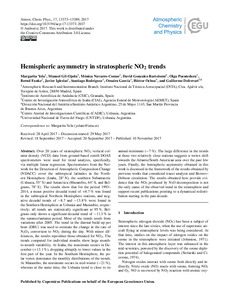Por favor, use este identificador para citar o enlazar este ítem:
http://hdl.handle.net/20.500.11765/7043
Hemispheric asymmetry in stratospheric NO2 trends
| Título : | Hemispheric asymmetry in stratospheric NO2 trends |
| Autor : | Yela González, Margarita; Gil-Ojeda, Manuel; Navarro Comas, Mónica; González-Bartolome, David; Puentedura, Olga; Funke, Bernd; Iglesias, Javier; Rodríguez, Santiago; García Rodríguez, Omaira Elena



|
| Palabras clave : | Nitrogen dioxide; Stratospheric trends; Ozone; Differential optical absorption spectroscopy (DOAS); Dióxido de nitrógeno; Ozono; Espectroscopía Óptica de Absorción Diferencial |
| Fecha de publicación : | 2017 |
| Editor: | European Geosciences Union |
| Citación : | Atmospheric Chemistry and Physics. 2017, 17(21), p. 13373–13389 |
| Versión del editor: | https://dx.doi.org/10.5194/acp-17-13373-2017 |
| Resumen : | Over 20 years of stratospheric NO2 vertical column density (VCD) data from ground-based zenith DOAS spectrometers were used for trend analysis, specifically, via multiple linear regression. Spectrometers from the Network for the Detection of Atmospheric Composition Change (NDACC) cover the subtropical latitudes in the Northern Hemisphere (Izaña, 28° N), the southern Subantarctic (Ushuaia, 55° S) and Antarctica (Marambio, 64° S, and Belgrano, 78° S). The results show that for the period 1993–2014, a mean positive decadal trend of +8.7 % was found in the subtropical Northern Hemisphere stations, and negative decadal trends of −8.7 and −13.8 % were found in the Southern Hemisphere at Ushuaia and Marambio, respectively; all trends are statistically significant at 95 %. Belgrano only shows a significant decadal trend of −11.3 % in the summer/autumn period. Most of the trends result from variations after 2005. The trend in the diurnal build-up per hour (DBU) was used to estimate the change in the rate of N2O5 conversion to NO2 during the day. With minor differences, the results reproduce those obtained for NO2. The trends computed for individual months show large month-to-month variability. At Izaña, the maximum occurs in December (+13.1 %), dropping abruptly to lower values in the first part of the year. In the Southern Hemisphere, the polar vortex dominates the monthly distributions of the trends. At Marambio, the maximum occurs in mid-winter (−21 %), whereas at the same time, the Ushuaia trend is close to its annual minimum (−7 %). The large difference in the trends at these two relatively close stations suggests a vortex shift towards the Atlantic/South American area over the past few years. Finally, the hemispheric asymmetry obtained in this work is discussed in the framework of the results obtained by previous works that considered tracer analysis and Brewer–Dobson circulation. The results obtained here provide evidence that the NO2 produced by N2O decomposition is not the only cause of the observed trend in the stratosphere and support recent publications pointing to a dynamical redistribution starting in the past decade. |
| Patrocinador: | Long-term measurements were made possible thanks to the funding provided by EU Framework programme NORS (FP7/2007-2013 under grant agreement no. 284421) and Spanish R+D Plan projects AMISOC (CGL2011-24891), AVATAR (CGL2014-55230-R), VIOLIN (CGL2010-20353) and HELADO (CTM2013-41311-P). The trend analysis was programmed with the GNU OCTAVE version 4.2.0 free software. |
| URI : | http://hdl.handle.net/20.500.11765/7043 |
| ISSN : | 1680-7316 1680-7324 |
| Colecciones: | Artículos científicos 2015-2018 |
Ficheros en este ítem:
| Fichero | Descripción | Tamaño | Formato | ||
|---|---|---|---|---|---|
| acp-17-13373-2017.pdf | 8,41 MB | Adobe PDF |  Visualizar/Abrir |
Los ítems de Arcimis están protegidos por una Licencia Creative Commons, salvo que se indique lo contrario.





